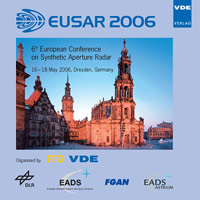Improved PSLR Estimation from SAR Images by Consideration of the Clutter Background
Conference: EUSAR 2006 - 6th European Conference on Synthetic Aperture Radar
05/16/2006 - 05/18/2006 at Dresden, Germany
Proceedings: EUSAR 2006
Pages: 4Language: englishTyp: PDF
Personal VDE Members are entitled to a 10% discount on this title
Authors:
Letsch, Klemens; Berens, Patrick (FGAN-FHR, D-53343 Wachtberg-Werthhoven, Germany)
Abstract:
Besides spatial resolution, the peak sidelobe ratio (PSLR) is another important parameter to assess the quality of a SAR system. For the verification of SAR performance parameters, usually the point target responses of a number of ground-fixed reference targets such as corner reflectors or active transponders are evaluated in the processed SAR image. The area around these reference targets should consist of a (natural) cover with a mean backscattering coeffcient as small as possible in order to limit the backscattered clutter energy. For SAR systems with moderate PSLR requirements the effect of this clutter can mostly be neglected and the PSLR is determined in a classical manner by the estimation of mainlobe and maximum sidelobe amplitudes from the range and azimuth section of the two-dimensional point target response. The verification of high performance SAR systems, where challenging performance specifications have to be fulfilled, requires a more accurate PSLR estimation in order to achieve more reliable verification results. Hence, the clutter background of the surrounding target area has to be taken into account. Due to the clutter’s statistical nature the superposition of the clutter with the undisturbed point target signal is stochastic, therefore the (squared) amplitudes of the mainlobe and maximum sidelobe can be modelled as random variables. In the paper a combined deterministic-statistical approach is suggested where the PSLR is regarded as a deterministic ratio of two random variables. The deterministic part is necessary because the fully statistical modelling of the PSLR results in an infinite variance so that the determination of useful (finite) error bounds becomes impossible. The approach uses a clutter model with an underlying complex Gaussian process and exploits the statistical properties of the squared mainlobe and sidelobe amplitudes with consideration of the point target radar cross section (RCS) and the clutter’s mean backscattering coefficient. Error bounds of the estimated PSLR are derived which are based on established parameters such as signal-to-clutter ratio (SCR), the classically defined PSLR of a clutter-free point target and the σ naught of the local clutter background surrounding the target test site. Furthermore some simulational results are presented to compare and evaluate the calculated error bounds.


